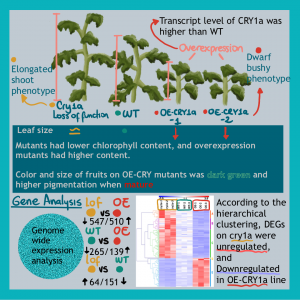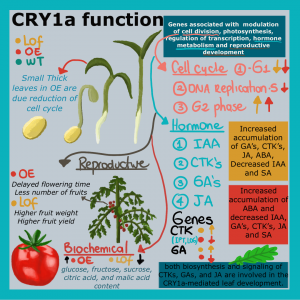Plant Point of View: Tomato CRY1a
Written and Illustrated by Laura Mejia. Click on images to enlarge.
Liu et al. (2018) analyzed how cryptochrome, CRY1a, affects developmental processes in tomato. They found that this photoreceptor contributes to the regulation of the plant responses to light including the inhibition of hypocotyl growth and the expansion of leaves and cotyledons, and that these processes are regulated by phytohormones.
 The authors compared over-expression (OE) and loss-of-function (LOF) alleles to wild-type plants through several assays: 1. Leaf analysis of chlorophyll and carotenoid content, 2. Vegetative and reproductive characterization with analysis on height, leaf number, size, and thickness, 3. Sugar and carotenoids in fruits through HPLC, 4. Phytohormone analysis, particularly índole acetic acid (IAA), salicylic acid (SA), jasmonic acid (JA), abscisic acid (ABA), cytokinin (CTK), gibberellins (GA), 5. Nuclear DNA content, to analyze cell cycle distribution, 6. Transcriptome analysis through RNA-seq.
The authors compared over-expression (OE) and loss-of-function (LOF) alleles to wild-type plants through several assays: 1. Leaf analysis of chlorophyll and carotenoid content, 2. Vegetative and reproductive characterization with analysis on height, leaf number, size, and thickness, 3. Sugar and carotenoids in fruits through HPLC, 4. Phytohormone analysis, particularly índole acetic acid (IAA), salicylic acid (SA), jasmonic acid (JA), abscisic acid (ABA), cytokinin (CTK), gibberellins (GA), 5. Nuclear DNA content, to analyze cell cycle distribution, 6. Transcriptome analysis through RNA-seq.
 Loss-of-function mutants have an elongated shoot phenotype, and the overexpression mutants have a dwarf bushy phenotype with a decreased plant height. LOF mutants have higher level of chlorophyll and carotenoids per weight, but lower levels by area, due to the leaves being thinner. OE mutants had small, dark green fruits. The transcriptome analysis showed numerous differentially regulated genes, with most showing opposite effects between OE and LOF lines.
Loss-of-function mutants have an elongated shoot phenotype, and the overexpression mutants have a dwarf bushy phenotype with a decreased plant height. LOF mutants have higher level of chlorophyll and carotenoids per weight, but lower levels by area, due to the leaves being thinner. OE mutants had small, dark green fruits. The transcriptome analysis showed numerous differentially regulated genes, with most showing opposite effects between OE and LOF lines.
 Most of the differentially regulated genes were associated with the modulation of cell division, light signaling transcription factor, photosynthesis relating genes, regulation of plant growth, and hormone metabolism. LOF mutants showed fewer cells in G1 phase, and the OE mutants had more cells in G2 and fewer in S phase; these parameters correlate with the size of the leaves and plant stature. Finally, LOF mutant fruits had less glucose, fructose and other sugars, with the OE fruit having higher levels. These results show the importance of this photoreceptor in the control of several hormones and the growth and development of tomato plants. Since this CRY is associated with agronomic features, it could be used to manipulate the fruit quality in tomato.
Most of the differentially regulated genes were associated with the modulation of cell division, light signaling transcription factor, photosynthesis relating genes, regulation of plant growth, and hormone metabolism. LOF mutants showed fewer cells in G1 phase, and the OE mutants had more cells in G2 and fewer in S phase; these parameters correlate with the size of the leaves and plant stature. Finally, LOF mutant fruits had less glucose, fructose and other sugars, with the OE fruit having higher levels. These results show the importance of this photoreceptor in the control of several hormones and the growth and development of tomato plants. Since this CRY is associated with agronomic features, it could be used to manipulate the fruit quality in tomato.
Read the full article: Liu, C‐C, Ahammed, GJ, Wang, G‐T, et al. Tomato CRY1a plays a critical role in the regulation of phytohormone homeostasis, plant development, and carotenoid metabolism in fruits. Plant Cell Environ. 2018; 41: 354– 366. https://doi.org/10.1111/pce.13092
 Laura Alejandra Mejía is a biologist, MSc pharmaceutical sciences from Universidad Nacional de Colombia, and a 2019 Plantae Fellow. My main interests are plant biology, application of plant metabolites, and the creation and dissemination of science for the public. You can follow me on Twitter @Eusoulaura16 and Instagram: @eusoulaura16.
Laura Alejandra Mejía is a biologist, MSc pharmaceutical sciences from Universidad Nacional de Colombia, and a 2019 Plantae Fellow. My main interests are plant biology, application of plant metabolites, and the creation and dissemination of science for the public. You can follow me on Twitter @Eusoulaura16 and Instagram: @eusoulaura16.




